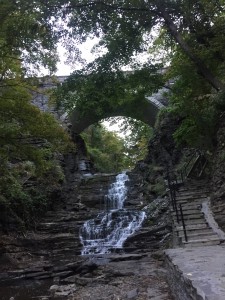There’s never a time where the Ithaca Gorges are not as they cheesily say, “Gorges (gorgeous)”. Even during the winter, the icy majestic falls look like beautiful streams frozen in time, awaiting the warmth of spring to give them life again. Of course, that’s not to say that experiencing them in warmer weather is not equally as breathtaking. And seeing them more than once only helps to enhance the experience with each additional time. The more you view them, it seems, the more you appreciate them in a small way. This past Saturday, for example, was the third time I had walked through the Cascadilla Gorge trail and it had only been exponentially more beautiful than the first (the beautiful cool autumn weather may have helped). Having House Fellow Todd Bittner join us in sharing his knowledge of the local geology only helped to garner an even greater appreciation for the gorges.
Learning more about the historical context of the trail had the impact of unveiling the inner beauty of the gorges. Thanks to Colonel Henry Sackett, the trail was originally created as a trail network to connect the downtown boarding houses with campus, facilitating the commute for Cornell students. However, the gorge trail has since changed significantly, slowly being eroded by overuse and Ithaca’s unforgiving weather conditions. In fact, seven out of the eight most recent years were devoted to reconstructing it alone.
The gorge itself shows a lot about the history of life in Ithaca, as well. For example, the elevation levels of the falls had significantly decreased, attributing to the overwhelming volumes of water continuously flowing through and eroding the rock beneath. Bittner also noted the 89 degree lacerations against the walls of the gorge, also created through the erosion of water, and the expansion of ice in the water. It’s strange to realize that such simple characteristics serve to accentuate the aesthetic of the gorges and how impactful nature can be in all manners of life.


I also thought it was really cool to learn more about the history of the gorge. Especially how it is intertwined with the history of Cornell.